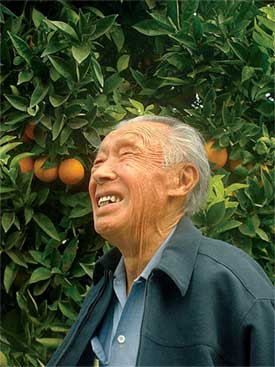NAME: Eiichi “Ed” Sakauye
CITY OF RESIDENCE: San Jose
Ed Sakauye is a remarkable man, bringing honor to the word “neighbor.” It was an act of goodwill more than 80 years ago that forever changed his life and has allowed him to live on the same plot of land he has always called home.
“I’ve been here all my life, which is over 92 years,” says Sakauye as he climbs aboard a tractor he built decades ago. The tractor is just one of several machines he uses to work his land, a farm that sits sandwiched between massive office buildings on the edge of Downtown San Jose.
ONCE A FARMER, ALWAYS A FARMER
Sakauye has seen the many faces of Silicon Valley’s evolution. His father was a pear-growing pioneer and owned nearly 200 acres. Together with other Japanese-American families, the Sakauyes produced 50 percent of the Valley’s fruit and vegetable crop.

“I was working in this field as a toddler. During high school, Dad would pick me up from school and I’d immediately change my clothes and be out in the field until dark.”
Today, Sakauye still grows a variety of Asian fruits, but he takes the most pride in his flowers. They are symbols of appreciation, grown in tribute to the neighbor that saved his farm during the darkest time of his life.
THE MOVE TO WYOMING
Shortly after the start of World War II, the Sakauyes, like thousands of other Japanese-American families in the South Bay, were forced off their land and sent to board a train for parts unknown. They were taken to an internment camp in Heart Mountain, Wyoming, a barren land that had nothing in common with what they once had.
“We were a dead people who didn’t know what to do or say. This hill country had never been farmed.” But the Sakauyes, with hundreds of fellow internees, put their years of farming knowledge to work and turned the acreage into a highly productive agricultural wonderland.
“We were trying to make a community where we could live and enjoy, under the circumstances,” recalls Sakauye, who served as the camp’s postmaster and weather observer. He was a model citizen who wanted nothing more than to film the activities inside the barbed-wire compound. The government banned any pictures from being taken inside the camp, but a persistent Sakauye eventually received permission to send for his cameras. He spent his final year in confinement filming and photographing life at Heart Mountain. At 88, Sakauye finally published his pictorial memoirs. There is no other documentation like it from any camp.
RETURNING HOME
When the Sakauye family returned home, they found their farm to be as it was, unlike many other properties that had been seized and ransacked. Their neighbor, Edward Seely, had looked after and protected the ranch. After all, Seely felt that he owed it to the Sakauyes. During World War I, when Seely was called to duty, he was faced with leaving behind his neighboring farm and his invalid mother.
“We looked after his mother and the property, and when Edward Seely returned, he was very well pleased that his mother didn’t look any worse, if not better,” says Sakauye.
THE FLOWERS
That’s why Sakauye, today, takes great pride in the flowers he grows. Every week, he and his wife take these colorful symbols and place them on the grave of Edward Seely, the man who made it possible for Ed Sakauye to work on his land for the rest of his life.


